Hint: State and explain Mendel’s traits of inheritance, in order to understand how traits are inherited from one generation to next.
Question.1. Which statement explains the Mendel’s law of segregation?
(a) A trait in an offspring is due to the combination of an allele each from both the parent.
(b) A trait in an offspring is due to the combination of two alleles each from both the parent.
(c) A trait in an offspring is due to the combination of two alleles each from either of the parent.
(d) A trait in an offspring is due to the combination of one allele each from either of the parent.
Question.2. The inheritance of color trait in flower is as shown. 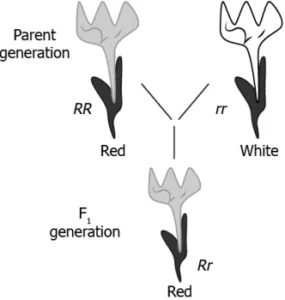
(a) Only Law of segregation
(b) Only Law of independent assortment
(c) Law of segregation and Law of dominance
(d) Law of segregation and Law of independent assortment
Ans.1. (a) A trait in an offspring is due to the combination of an allele each from both the parent.
Ans.2. (c) Law of segregation and Law of dominance
Hint: Explain the combination of sex chromosomes, in order to understand how sex is determined in humans.
Question.3. Humans have two different sex chromosomes, X and Y. Based on the Mendel’s laws, a male offspring will inherit which combination of chromosomes?
(a) both the X chromosomes from one of its parents
(b) both the Y chromosomes from one of its parents
(c) combination of X chromosomes from either of its parents
(d) combination of X and Y chromosome from either of its parents
Question.4. Two individuals are as shown using geometric shapes.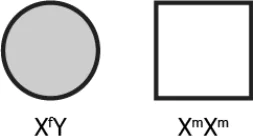
(a) X^{f}X^{m} and X^{m}X^{m}
(b) X^{m}Y and X^{m}X^{m}
(c) X^{f}Y and X^{m}Y
(d) X^{m}Y and X^{m}X^{f}
Ans.3. (d) combination of X and Y chromosome from either of its parents
Ans.4. (d) X^{m}Y and X^{m}X^{f}
Hint: Classify the given traits as inherited or acquired, in order to understand which traits cause a change in genes.
Question.5. An individual is tall with black hair, and free earlobes. The individual learnt to play football from his father and got a scar on his forearm in a match. Which table shows the correct classification of his traits into acquired traits and inherited traits?
(a) 
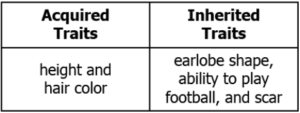
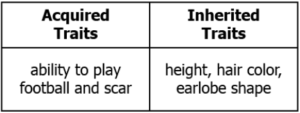
Question.6. The image shows the traits present across generations of a family. 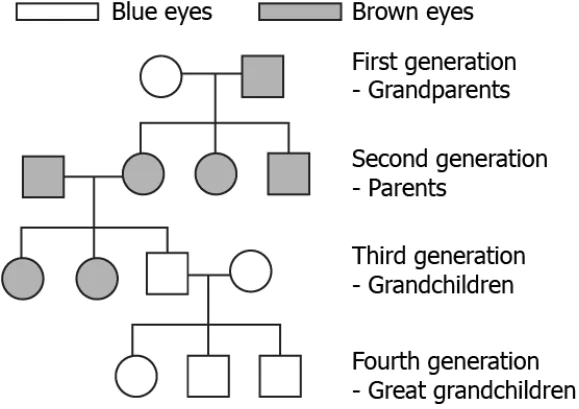
(a) Acquired trait because both male and females have it.
(b) Acquired trait because it is expressed in all the generations.
(c) Inherited trait because it is expressed in two different colors.
(d) Inherited trait because it depends on the traits of preceding generation.
Ans.5. (d) 
Hint: Explain how changes in DNA can lead to stronger/ better species, or formation of new species altogether, in order to understand natural selection & speciation.
Question.7. In which case does the change in DNA contributes to speciation?
(a) changes in the DNA of zygote
(b) changes in the DNA of brain cells
(c) changes in the DNA of bone cells
(d) changes in the DNA of sperm cells
Question.8. The image shows the extent of similarity in the DNA of humans and the organisms.
(a) Newly evolved species have inactive ancestral genes.
(b) Species retain their DNA and evolve new proteins with time.
(c) Some of the genes remain conserved during the evolution of species.
(d) Species undergo a complete change of DNA sequences as they evolve.
Ans.7. (d) changes in the DNA of sperm cells
Ans.8. (c) Some of the genes remain conserved during the evolution of species.
Hint: Identify if a given pair of organs is analogous or homologous, in order to find relationship between species.
Question.9. Which of this is a pair of an analogous organ?
(a) wings of a pigeon and a bat
(b) forelimbs of a frog and a bird
(c) forelimbs of a rabbit and a lizard
(d) leaves of a pitcher plant and a Venus fly trap
Question.10. A student studies that the wings of birds are covered by feathers whereas that of bats are skins folds stretched mainly between elongated fingers. Their wings vary in design, structure and components and thus they are very different. They look similar only because they both are used for flying. He also studied that their origin is not common. What type of organs are the wings of these two species?
(a) homologous, as both wings are used for flying
(b) analogous, as wings of both are similar in design
(c) analogous, as they do not have a common origin
(d) homologous, as components of the wings are similar
Ans.9. (a) wings of a pigeon and a bat
Ans.10. (c) analogous, as they do not have a common origin
Hint: Observe different fossils and identify the differences and similarities, in order to understand the timeline of evolution.
Question.11. The image represents a marine organism that was present 65 million years ago.
(a) the size of the animal increases
(b) the size of the animal decreases
(c) the complexity of the suture line increases
(d) the complexity of the suture line decreases
Question.12. The image represents the fossil record of a species that was found from different layers of the soil along with the possible match animal shape.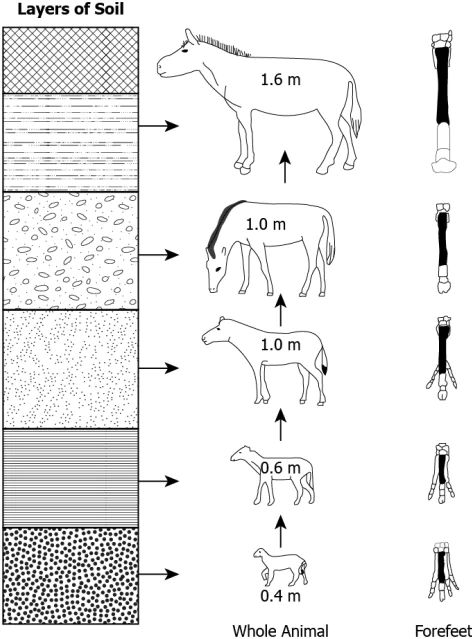
(a) growth of the animal over time
(b) evolution of the animal over time
(c) appearances of new form of animal over time
(d) an increase in the length of the fossils due to weight of the upper layers of rock
Ans.11. (c) the complexity of the suture line increases
Ans.12. (b) evolution of the animal over time



